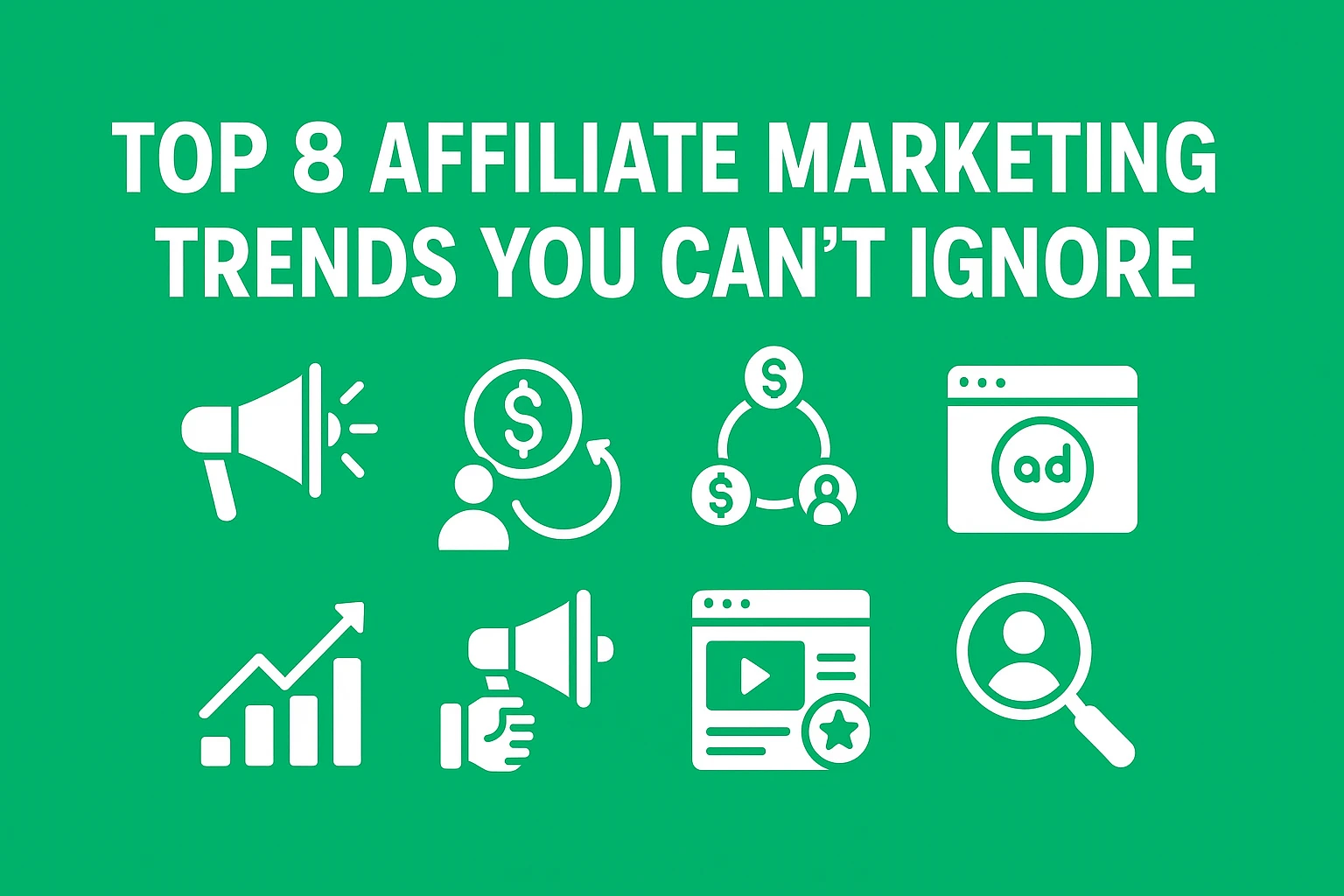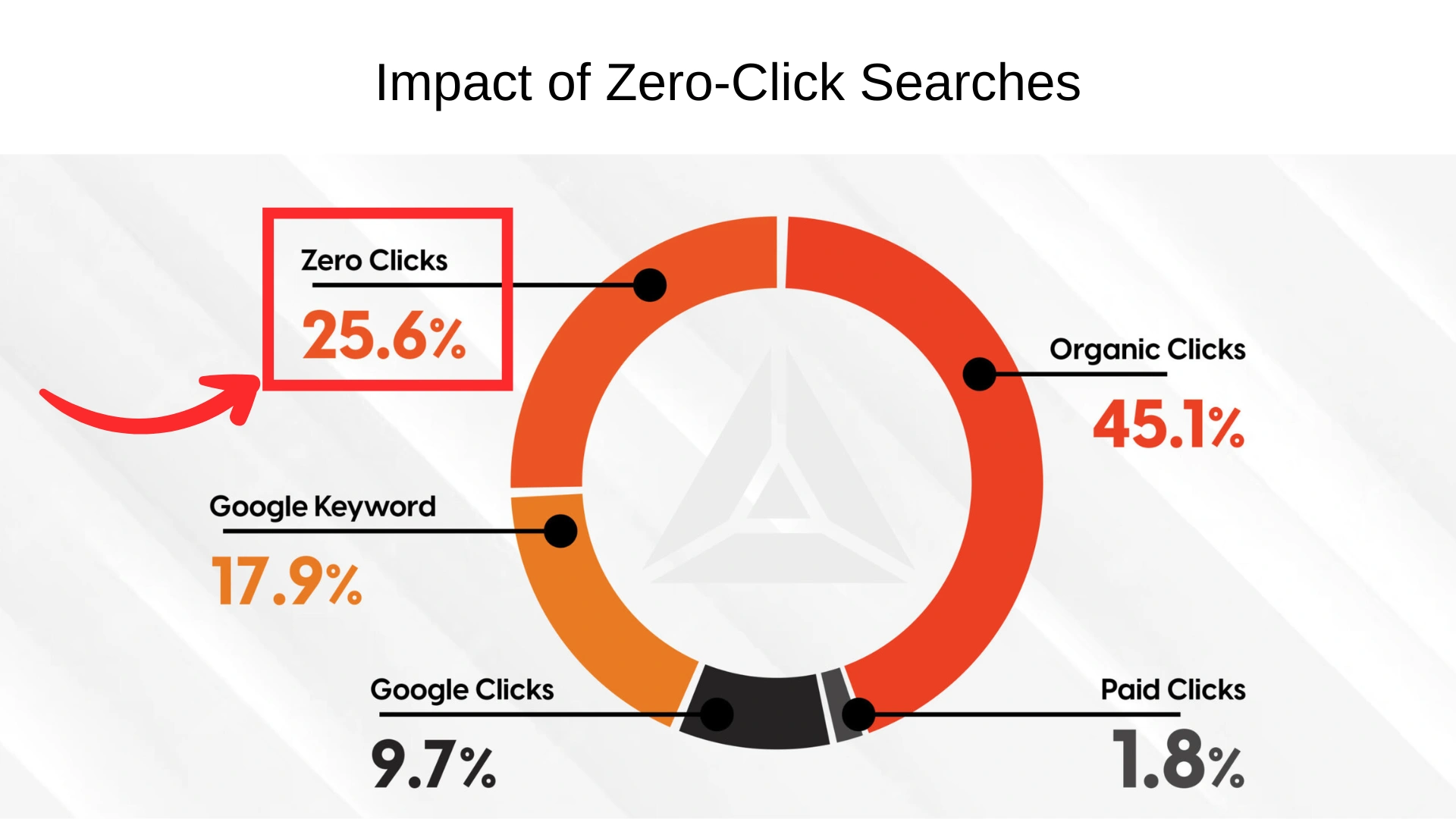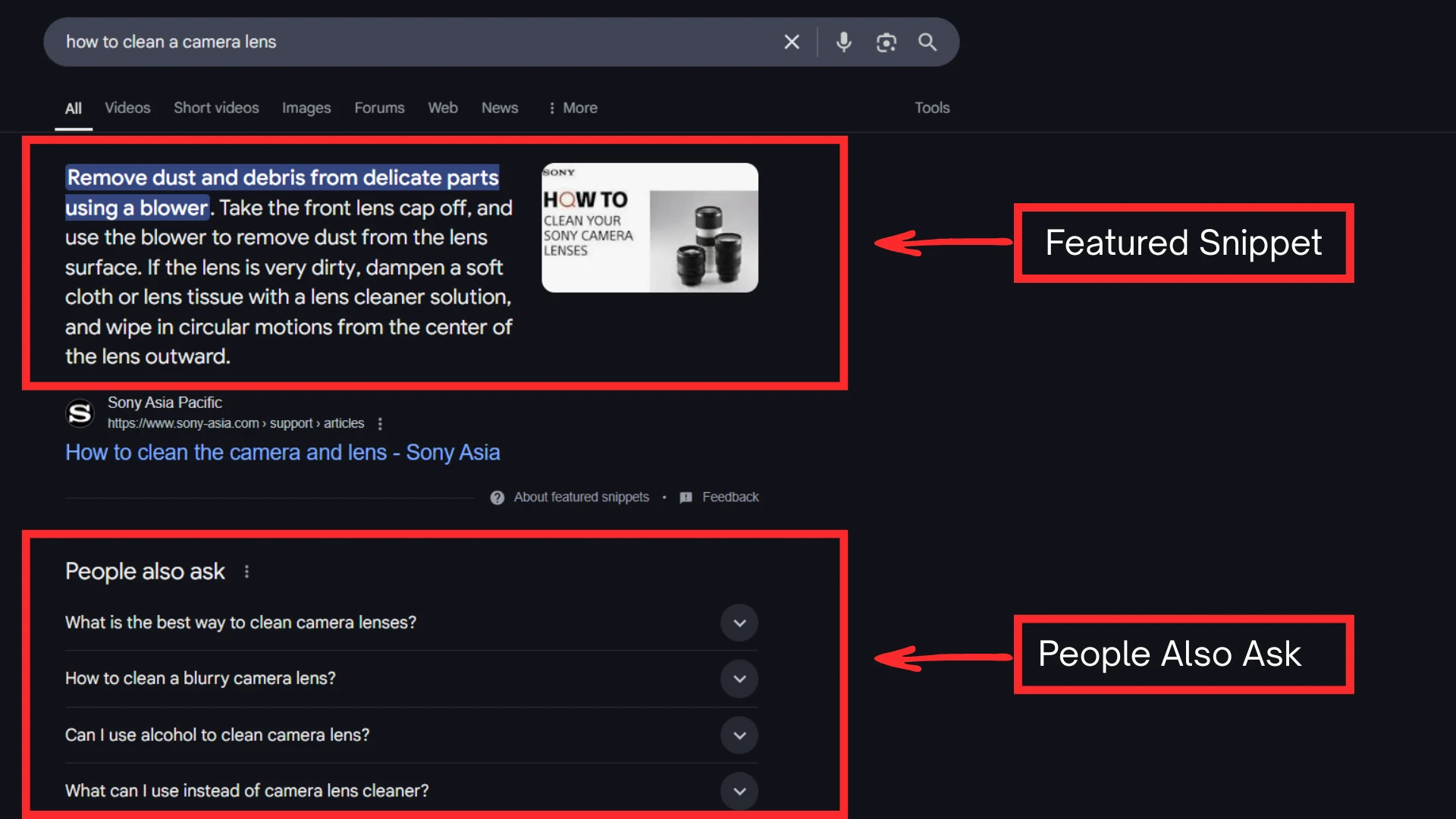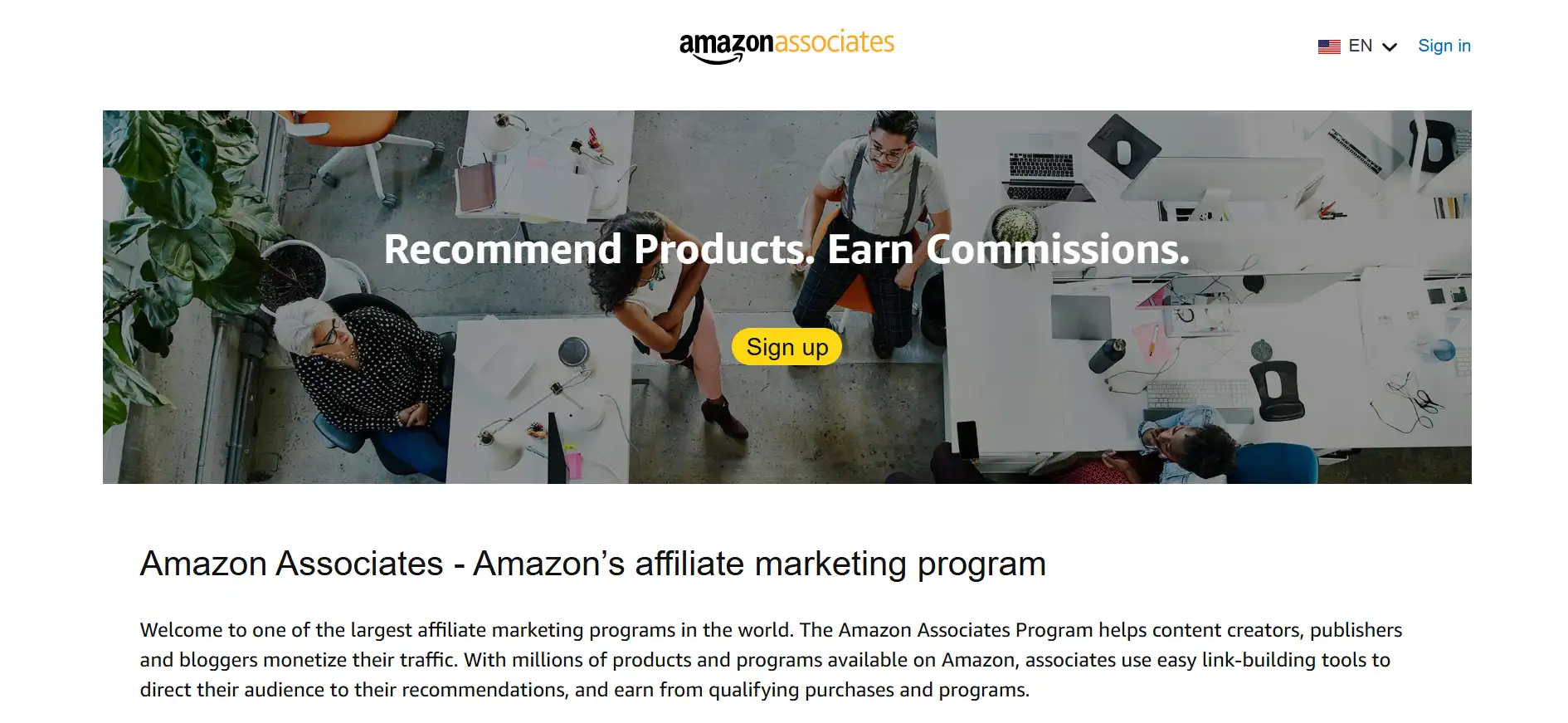Top 8 Affiliate Marketing Trends You Can’t Ignore in 2025 (If You Want to Stay Relevant)
Discover the top 8 affiliate marketing trends for 2025 that smart marketers are using to boost traffic and sales. Stay ahead or get left behind.

The other day, I was scrolling through my favorite marketing forum on Reddit (you know, the kind where people share their wins and fails), and someone asked, “What’s next for affiliate marketing in 2025?” It got me thinking because, honestly, this space changes faster than my morning coffee gets cold.
I mean, remember when we thought banner ads were the gold standard?
That feels like ancient history now. Last year alone, AI tools exploded. Some affiliates used them to write faster, rank higher, and scale like crazy. Others watched their traffic drop because Google crushed low-effort content.
TikTok-style video reviews started pulling more clicks than long-form blogs. Brand deals got stricter. Email open rates dipped for those not keeping up.
If you missed just one major shift, you probably lost ground—fewer clicks, lower commissions, maybe even months of wasted work.
Staying sharp isn’t optional anymore. These days, you either adapt or fall behind.
That’s why I put this together. These eight trends aren’t just predictions. They’re signs of where affiliate marketing is already moving. If you want to keep earning and stay relevant, these are the shifts to watch now—not later.
📌Key Takeaways
- Staying updated with affiliate trends is key to staying profitable in 2025.
- AI tools, voice search, and video are driving how people find and trust content.
- Building trust and collecting your own data will matter more than ever.
- Google rewards niche focus and clear, expert-driven content.
- Affiliate programs expect more compliance and transparency from partners.
- Trends aren’t just noise—they point to real shifts in how people buy and search.
- Make small changes now to avoid big problems later.
8 Affiliate Marketing Trends You Can’t Ignore
Let’s get into it…
Trend 1: AI-Driven Content Is Getting Smarter

AI tools aren’t just spinning articles anymore. They’re writing product comparisons, answering search queries, building outlines, suggesting headlines, and even editing for tone.
And they’re doing it better than they did six months ago. Tools like ChatGPT, Jasper, and Koala are learning how to sound more human and less robotic, which means they’re being used across thousands of affiliate sites—some good, some spammy.
What it means for affiliate marketers
You’re no longer competing with just people. You’re competing with machines backed by full-scale content pipelines. Solo affiliates and small teams are publishing ten times more articles than before.
That’s great for scaling—but it also means there’s more noise, more duplicate ideas, and tougher competition in search results.
AI is helping marketers pump out content faster, but that speed can be a trap. If you rely too heavily on AI without a clear strategy or human editing, your site starts sounding generic. And Google’s March 2024 update cracked down on that hard.
Thousands of AI-heavy affiliate sites got buried because they lacked originality or helpfulness.
How it impacts SEO, content scaling, and trust
SEO is shifting. Google isn’t just checking for keywords—it’s looking for content that shows real experience and value.
So if your blog post on “best budget headphones” reads like the same AI-written list everyone else is using, it won’t rank. Even worse, readers won’t trust it. They want insights that feel real—personal opinions, test results, comparisons that go deeper than surface level.
Content scaling still matters. You need more pages to grow traffic. But now, quality has to scale with quantity. Some marketers are mixing AI with firsthand reviews, custom photos, or recorded demos. That combo builds trust and beats plain text.
For example, a niche site reviewing power tools used AI to outline its posts but added original photos, real test videos, and quotes from contractors. Rankings shot up in three months.
Quick tip: Use AI as a helper, not a crutch
AI can help you brainstorm, outline, draft, and rewrite—but the final polish should come from you. Add personal takes, test the products, speak in your real voice. Think of AI as your assistant, not your replacement. That’s how you scale smart and stay trusted.
Recommended Reading: 9 Best Free AI Writing Tools Every Affiliate Marketer Should Try
Trend 2: Voice Search and Conversational Queries

More people are talking to their phones than typing. Voice assistants like Siri, Google Assistant, and Alexa aren’t just for setting alarms anymore.
People ask them real questions—like “What’s the best protein powder for beginners?” or “Which budget laptop can run Photoshop?” That shift is changing how search works.
More people are using voice assistants
Think about how people talk versus how they type. Someone typing might search “best DSLR camera 2025.” But someone using voice will say, “What’s the best DSLR camera I can buy for under a thousand dollars?” That longer, natural-sounding query is called a conversational search.
And it’s not just Gen Z using it—busy parents, older folks, and everyday users are doing it because it feels easier.
By 2025, voice searches are expected to account for more than 30 percent of all browsing. And a big chunk of those are product-related. So if your affiliate content isn’t matching how people speak, you’re missing real traffic.
Focus on natural language and long-tail keywords
This is where affiliate marketers need to adjust. Stop stuffing keywords like “best running shoes 2025” into every paragraph. Instead, write like you’re answering someone’s real question. Use full phrases, casual language, and long-tail keywords that match how people talk.
It’s not just better for voice—it’s also what Google is rewarding.
For example, a site reviewing meal delivery kits added headings like “Which meal kit is best for picky eaters?” and “Can I cancel a subscription anytime?” These match real voice queries. As a result, those posts started ranking in featured snippets and pulling in more organic traffic without extra backlinks.
Quick win: Add FAQ-style sections
If you want to catch voice traffic fast, drop an FAQ section at the end of your posts. Use questions your audience is actually asking. Tools like AnswerThePublic, AlsoAsked, or even Reddit threads in your niche can give you those exact phrases.
Keep answers short and clear—aim for 40 to 50 words. That’s the sweet spot for Google snippets and voice responses. You don’t need to guess. Just listen to how people talk, and write like you’re chatting with them.
Trend 3: First-Party Data Is Gold Now
Third-party cookies are on their way out. Google’s phasing them out in Chrome, and Safari and Firefox already did. That means tracking people across sites is getting harder—and affiliate marketers can’t rely on old methods to retarget or personalize offers anymore.
Cookie restrictions are here
For years, we used cookies to follow users, show retargeting ads, and gather data without much effort. That’s fading fast. With stricter privacy rules like GDPR and growing ad blockers, platforms are cutting off easy access to that data. So unless you own the relationship, you’re flying blind.
Affiliate tracking still works—don’t panic—but building long-term trust and repeat sales without your own data is now a major risk.
Build your own audience lists
This is where first-party data comes in. It’s the stuff you collect directly: email addresses, phone numbers, survey responses, purchase behavior. When you own that, no browser update or algorithm shift can take it away.
Smart affiliates are treating their websites like lead machines. Instead of just sending people straight to product links, they’re offering something first—a free checklist, a quick quiz, a mini-course, even an exclusive discount.
That way, they capture the email or phone number before the click. Now they can follow up, build trust, and promote more than once.
Highlight email, SMS, and quizzes
Email and SMS are making a comeback in affiliate marketing—not the spammy kind, but smart, targeted follow-ups. If someone signs up through your blog post about budget fitness gear, you can send them a weekly tip, a gear review, or a deal they’ll actually care about.
Quizzes are another big play. They work great for product discovery and data collection.
For example, a skincare affiliate site added a “What’s Your Skin Type?” quiz. It gave personalized product suggestions and collected emails at the end. Conversions jumped because people felt like the site understood them.
You don’t need a fancy setup. Even simple lead capture with a strong hook can build a list over time.
First-party data isn’t just a bonus anymore. It’s your safety net. If platforms shift or cookies die off completely, your list is what keeps you in the game.
Trend 4: Short-Form Video Is Dominating

Scroll through any platform—YouTube, Instagram, Facebook, even Pinterest—and short-form videos are everywhere.
TikTok kicked it off, but now YouTube Shorts and Instagram Reels are pulling huge views too. These quick, punchy videos are shaping how people discover and buy products. And that’s big news for affiliate marketers.
Here Are Some Stats That Prove Short-Form Video Is Taking Over
- 73% of users prefer short videos to learn about products.
- 88% of marketers say short-form video gives them the highest ROI.
- YouTube Shorts, Instagram Reels, and TikTok drive major affiliate traffic.
- 1 in 3 affiliate marketers say short videos bring the best conversions.
YouTube Shorts, Reels, and TikTok influence buying
People aren’t reading long blog posts before they buy like they used to. They’re watching 15 to 60-second clips that show a product in action. TikTok videos with the hashtag “#TikTokMadeMeBuyIt” have billions of views. It’s real buying behavior shifting toward fast, visual content.
Let’s say someone wants a new wireless mouse. Instead of reading a review, they search TikTok or Shorts to see how it works—how it clicks, glides, lights up, fits in the hand. The same applies to fitness gear, kitchen gadgets, fashion, and beauty products.
One solid short-form video can do more than a full blog post if it hits the right moment.
A creator I follow reviewed a mini espresso machine in a 45-second clip—clean demo, no fluff, just the essentials. That single video brought in thousands of clicks to his affiliate link because it answered the exact question people had: “Does this thing actually work?”
Use product demos, quick tips, and comparisons
If you’re not on video yet, start small. You don’t need to dance or go viral. Just show the product, talk to the camera, or even use voiceover with text. Think simple: unboxings, side-by-side comparisons, “3 things I like and don’t like,” or quick how-to videos.
Shorts work because they’re fast, easy to consume, and perfect for people who want to see value before clicking. If you’re promoting physical products, it’s almost a no-brainer. Even for digital products, a quick walkthrough or tip series can build trust.
Mention tools like InVideo or CapCut
Don’t overthink production. Tools like CapCut and InVideo make editing easy, even if you’re new to video. CapCut works great for mobile editing, especially with trending TikTok or Reels-style templates.
InVideo is ideal for repurposing blog content into short videos with text overlays, images, and stock footage.
A niche gadget site I consulted used InVideo to turn their top blog posts into video summaries with product shots, short voiceovers, and captions. Within a month, their YouTube Shorts brought in more traffic than their blog ever did—without any major SEO push.
If you’re not creating short-form video, you’re invisible to a big chunk of buyers. This isn’t a nice-to-have anymore. It’s the new front door for affiliate traffic. Start where your audience hangs out, keep it simple, and show what matters fast.
Trend 5: Niche Sites Are Outperforming Broad Ones
Affiliate marketers used to chase big, broad categories—tech, fitness, home, finance—thinking more topics meant more traffic. But now, those catch-all sites are struggling.
Google’s updates in 2023 and 2024 made it clear: authority matters, and it’s tied to focus. Niche sites, the ones that go deep on one subject, are winning.
Google favors expertise
Google’s algorithm updates now favor content that shows real knowledge. If your site is about everything from drones to dog food, Google won’t trust you as much. But if your site is all about trail running shoes—testing, comparing, sharing personal reviews—you look like a real expert. That’s who Google wants to rank.
And it’s not just about keywords. It’s about depth, consistency, and topical relevance. When your content sticks to a single niche, internal links make more sense, user experience improves, and time on site goes up.
Google picks up on all of that.
Smaller, focused blogs build more trust
Readers trust specialists. If someone’s looking for the best travel backpacks and they land on a site that only talks about outdoor travel gear, they’re more likely to trust the review. That trust leads to clicks and conversions.
One affiliate I know runs a site dedicated to air purifiers—just that. No furniture, no wellness tips, nothing else. He reviews every new model, compares filters, and explains clean air ratings in simple terms. His traffic is lower than a lifestyle blog, but his conversion rates crush it because when people do find his content, they know they’re in the right place.
For example,
In a 2024 case study from Authority Hacker, niche sites in home brewing, fountain pens, and meal prep tools consistently outranked larger general sites even ones with more backlinks. Why? The content wasn’t just optimized. It was written by people who clearly understood the topic. They built topical authority.
In another instance, A niche site dedicated entirely to dash cams started outranking big-name auto blogs like Motor1 and The Drive—even though it had fewer pages and almost no backlinks.
The difference? Every article focused on dash cams only: setup guides, side-by-side comparisons, installation tips, even troubleshooting. The internal links made sense. Reviews weren’t generic since they showed real test footage and real opinions.
Readers didn’t have to dig. They came for dash cams, and that’s exactly what they got. Google picked up on that relevance fast, and within a few months, the site was sitting above the giants for competitive terms like “best dash cam for night driving” and “dash cam with parking mode.”
Takeaway: If you’re still trying to be the next Wirecutter, it’s time to rethink. Pick a lane. Go deep. Own it. Google will notice. And so will your readers.
Trend 6: Zero-Click Searches and SERP Features
Google isn’t just serving links anymore. It’s giving answers—right there on the results page. That means more users are finding what they need without ever clicking through to your site. These are called zero-click searches, and they’re becoming the norm.

Featured snippets, People Also Ask boxes
You’ve seen it. You type a question like “how to clean a camera lens,” and boom—there’s a clear, step-by-step answer at the top. That’s a featured snippet. Below it? A list of questions like “Can I use alcohol to clean my lens?”—that’s the People Also Ask box. Both pull content directly from websites, but they don’t always lead to clicks.
That sounds bad for affiliates, right? Not if you play it smart.

Optimize for visibility, not just clicks
The goal now isn’t just traffic. It’s presence. You want to show up wherever your audience is looking—even if they don’t click. Because when they see your brand often enough, they remember it. And when they’re ready to buy, they’ll trust you.
The good news? These boxes still pull your content. If your answer is clear, direct, and well-formatted, you’ve got a shot.
For example, I updated a blog post on “best email marketing tools for beginners” into a simple Q&A format. One section answered, “Is GetResponse good for small businesses?” in two straight-to-the-point lines.
Within a few weeks, that section showed up in the People Also Ask box on Google—no backlinks, no outreach. Just clear formatting and real intent.
Simple how-to schema boosts presence
Want even more visibility? Add schema markup—especially how-to and FAQ schema. This tells Google exactly what your content covers and helps it appear as rich results.
Let’s say you run a blog about espresso machines. A post like “How to descale a Breville Barista Express” could use a how-to schema with each step clearly outlined. Google might turn it into a snippet, or add step-by-step visuals to your search result. That’s huge for standing out.
Tools like Rank Math or Yoast can help you add schema easily without touching code.
The bottom line? You may get fewer clicks in 2025, but if your content earns a spot in SERP features, you’ll still win attention and authority. So format smart, answer clearly, and build trust—even before the click.
Trend 7: Affiliate Programs Are Getting Stricter
Affiliate programs aren’t just handing out links anymore. Over the last year, networks have started tightening the rules—especially big ones like Amazon, ShareASale, and CJ. They’re rejecting more sites, reviewing content more often, and even banning affiliates who don’t follow guidelines.
If your site feels spammy or lazy, you’re one update away from getting booted.
Recommended Reading: How to Apply and Get Approved by Affiliate Programs: A Step-by-Step Guide
Tighter compliance rules and quality checks
Amazon Associates is the most obvious example. They’ve always had strict terms, but now they’re actively cracking down on sites with thin content, excessive product links, or misleading claims. If your content isn’t updated or doesn’t add real value, they’ll cut you off—no warning.

Here’s Amazon’s current policy page: Amazon Associates Program Policies
They now expect clear disclosures, helpful context, and no misleading language. Even how you use images, logos, and buttons matters.
ShareASale has also started reviewing new applications more closely. If you don’t have a solid site with real traffic, it’s harder to get in. They want to see real content—not a landing page with 20 affiliate links and no substance. Read their rules here: ShareASale Affiliate Agreement
Focus on value-first content
What most programs want now is simple: trust and usefulness. They’re tired of affiliate sites that just exist to push links. Instead, they want partners who explain products clearly, give honest pros and cons, and help people make real decisions.
Take gear reviews, for example. Instead of a lazy list of Amazon links, strong affiliates are writing actual use cases, comparing products side-by-side, showing who the product is best for, and including personal experience. That kind of value gets clicks and keeps you compliant.
A food blog I follow recently updated all their affiliate posts to include cooking videos, ingredient tests, and taste comparisons. They stopped just linking to “the best blender” and started showing what it could do.
After that, they not only got better rankings—they were approved for more exclusive programs with higher payouts.
Recommended Reading: Why Valuable Content Wins in Affiliate Marketing (And How to Create It)
What it means for you
If you’re serious about affiliate income in 2025, you can’t treat compliance like an afterthought. Make sure every piece of content gives more than it takes. Update old posts. Add original insights. And always include proper disclosures. Programs are watching now. Your reputation—and commissions—depend on it.
Quick check: Would you still publish that article if affiliate links didn’t exist? If not, it’s time for a rewrite.
Trend 8: Ethical and Transparent Marketing Wins
People are done with shady tactics. Flashy claims, fake urgency, and vague reviews don’t cut it anymore.
In 2025, buyers are paying attention—and so are affiliate networks. If your content feels even a little dishonest, you’ll lose clicks, trust, and probably future earnings.
Audiences demand honesty
We’ve all seen the “Top 10 Must-Have Gadgets You Can’t Live Without” posts that don’t say much except “buy this now.” That kind of content used to bring in some traffic. Not anymore. Today’s audience wants to know: Have you used this product? Why do you like it? What didn’t work?
If they sense fluff or exaggeration, they bounce.
Trust is everything in affiliate marketing. And trust comes from being real—even if it means saying, “This one isn’t for everyone,” or “Here’s what I didn’t like.” That honesty turns readers into long-term followers. It also increases conversions, because people trust reviews that feel human.
Clear disclosures build trust
Hiding affiliate links is a fast way to lose credibility—and possibly get kicked from a program. Users respect transparency, and so do regulators. “That means saying clearly: This post contains affiliate links. If you buy through them, I may earn a commission—at no extra cost to you.“

It doesn’t have to be a legal wall of text. Keep it short and natural, but visible. Place it near the top of the post and again in the middle if it’s long. You can also mention it casually inside your content.
For example “I’ve tested a bunch of travel routers, but this one is the one I actually bring on trips (yes, it’s an affiliate link).”
That tone works. It keeps things honest and human.
Use storytelling over hype
Instead of pushing people to buy with empty promises, tell a real story. How did the product help you? What problem did it solve? What was frustrating at first? That’s the kind of content people relate to.
Recommended Reading: Why Storytelling in Affiliate Marketing Sells More Than Product Features
One creator I know wrote a post about switching from a cheap standing desk to a mid-range model after back pain got worse. No salesy copy—just a clear timeline, some photos, and real thoughts on why the second desk was better. That post still ranks and converts because it’s authentic.
People can tell when you’re being honest. And in 2025, they’ll reward you for it—with clicks, shares, and trust. Drop the hype, skip the hard sell, and show up like a real person. That’s the edge now.
Conclusion
Affiliate marketing isn’t the same game it was even a year ago. Platforms shift. Audiences expect more. Algorithms tighten. And what used to work—even just last quarter—might already feel stale.
These trends aren’t guesses. They’re real shifts happening now. AI isn’t going away. Video is only getting stronger. Compliance is tightening. And if you’re not building real trust with your audience, someone else will.
Don’t wait for your traffic to drop or your commissions to dry up before making changes.
Start now.
Pick one area—maybe short-form video or improving your content for snippets—and take action this week. Then build from there. The marketers who win in 2025 are the ones who adapt without losing their voice.
Keep things honest. Keep things helpful. Keep showing up. That’s how you stay relevant.
Frequently asked Questions
Is affiliate marketing still profitable in 2025?
Yes. Affiliate marketing is still profitable—if you follow current trends. Static blogs and thin content don’t cut it anymore. You need strong brand authority, community-driven promotion, and tools like AI to speed up content production. Pick the right niche, promote high-converting offers, and focus on trust. Success now leans more on credibility, not just traffic. Adapt your methods or get buried by smarter affiliates.
How is AI changing affiliate marketing?
AI helps affiliates write faster, optimize better, and target smarter. Tools like ChatGPT, Jasper, and Surfer SEO boost output and keyword planning. AI also personalizes user journeys, improves email funnels, and spots content gaps. But it’s not about pushing lazy content. Smart affiliates combine AI with real insights, case studies, and expert takes. That combo drives trust—and conversions. AI is your assistant, not your replacement.
What niches are trending in affiliate marketing for 2025?
Hot niches in 2025 include AI tools, remote work, creator gear, personal finance, and mental wellness. People want solutions fast, so “how-to” and tool comparison content works well. Evergreen niches like health, tech, and side hustles still perform, but success comes from deep focus. Niche down. Serve one type of user. Speak their language. That’s how you win in 2025.
Should I focus on short-form or long-form content in 2025?
Use both. Long-form builds authority and ranks on Google. Short-form hooks attention—especially on TikTok, Reels, and YouTube Shorts. A smart strategy? Break down long blog posts into short clips. Repurpose everything. Show your face or voice to build trust. The mix of content depth and quick value grabs attention, drives traffic, and keeps people coming back.
Why is first-party data a major affiliate marketing trend now?
With third-party cookies disappearing, first-party data is becoming a top affiliate marketing trend in 2025. You can’t rely on platforms to track users for you anymore. That means you need your own data—emails, quiz results, purchase history, or user behavior on your site. Building a solid email list is now essential. Use opt-ins, free downloads, SMS signups, and interactive tools like quizzes or calculators. This way, you’re in control. You can segment users, send more targeted offers, and drive repeat clicks. Email and SMS convert better than most social posts and give you a direct line to your audience.


Thanks for sharing. I read many of your blog posts, cool, your blog is very good.